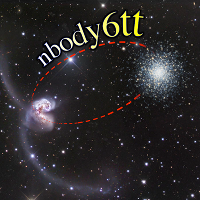nbody6tt
Description of the code

nbody6tt is based on nbody6 by Sverre Aarseth and includes the treatment of complex galactic tides in a direct N-body simulation of a star cluster, through the use of tidal tensors. This method is extremely general since any potential, including time-varying ones, and any orbit can be considered. (E.g. galaxy mergers, see Renaud & Gieles 2013.)
The method is fully described in Renaud, Gieles & Boily (2011).
Since v4.0, a another mode (called MODE B) allows to define the galactic potential as a function of position and time in nbody6tt, and to give the initial orbital parameters of the cluster as usual. The tensors are computed live by the software itself.
Download
Download the sources from GitHub. The released versions contain a README file (= user manual) and the list of changes that have been made on the official release of Nbody6.
nbody6tt relies on nbody6 that is often updated. The version (= date of download) of nbody6 used in nbody6tt is indicated in the README.md file.
nbody6tt is free to use. Reference should be made to Renaud, Gieles & Boily (2011), and a nice email is always appreciated!
If you want to be informed of the updates of nbody6tt, send me an email.
Examples of tidal tensors
You want to try nbody6tt but you don't have a simulation of galaxies? First, consider using it with MODE B (since v4.0, see above). Or you can use one of the tidal tensor files provided below. (I used them for the nbody6tt simulations presented in Renaud, Gieles & Boily (2011).) Download one of these files and rename it "tt.dat". In the input parameters, set KZ(14) to 9, and run nbody6tt!
| tt.dat_pt_circ_r1000 | Circular orbit at 1 kpc from a point-mass galaxy of 1010M⊙(named "Orbit A" in Renaud et al. 2011, Fig.5) |
| tt.dat_pt_circ_r3000 | Circular orbit at 3 kpc from a point-mass galaxy of 1010M⊙(named "Orbit B" in Renaud et al. 2011, Fig.5) |
| tt.dat_pt_ellip_e0.5 | Elliptical orbit of pericenter 1 kpc and apocenter 3 kpc (eccentricity = 0.5) around a point-mass galaxy of 1010M⊙(named "Orbit C" in Renaud et al. 2011, Fig.5) |
| tt.dat_plummer_extensive | Circular orbit at the caracteristic radius of Plummer potential(named "xi = 1" in Renaud et al. 2011, Fig.7) |
| tt.dat_plummer_compressive | Circular orbit at 0.66 caracteristic radius of Plummer potential(named "xi = 0.66" in Renaud et al. 2011, Fig.7) |
| tt.dat_antennae_orbitB | Orbit in the Antennae galaxies(see Fig.8 of Renaud et al. 2011, and orbit B in Fig.8 of Renaud et al. 2009) |
| tt.dat_ngc4038_orbitB | Same as before, but without the second galaxy colliding(see Fig.8 of Renaud et al. 2011) |
Help, feedback
Questions, bug reports, comments and suggestions are most welcome: florent.renaud<at>gmail.com
Example of results
The role of galaxy mergers in the evolution of star clusters (Renaud & Gieles 2013). The orbits are those of Fig. 1.